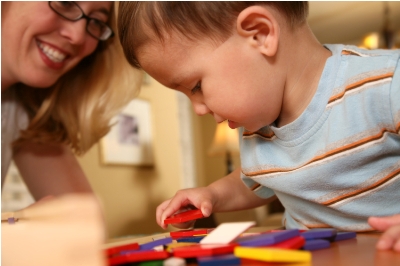Recently I’ve seen or heard a few questions about what it means to “follow the child”. It’s one of those Montessori phrases we throw around, but what does it really mean?
Since Maria Montessori divides ages into 6-year cycles, it’s helpful to do so for this topic as well. In the 0-6 age group, following the child typically means observing the child in the classroom and using their interests and level of ability as a guide.
Following the Child in 0-6
 This may influence what work is presented to the child and when. For instance, a teacher who notices when the child has mastered the cylinder blocks will then present the knobless cylinders. A parent who notices that a child needs to improve their fine motor skills will make several materials available that use fine motor skills.
This may influence what work is presented to the child and when. For instance, a teacher who notices when the child has mastered the cylinder blocks will then present the knobless cylinders. A parent who notices that a child needs to improve their fine motor skills will make several materials available that use fine motor skills.
Following the child is one place where Montessori differs considerably from traditional education. Rather than following a strict curriculum, where every child learns the same things every day, we use a more flexible approach. If there are 20 children in a classroom, there may be 20 different paths being followed in terms of order and repetition of presentations.
What accounts for this difference in philosophy? In Montessori, we believe that the child instinctively knows what he or she needs to do. In my time spent as a 3-6 assistant, I saw this proven over and over again. A child would try a work and struggle with it, then return to it (sometimes dozens of times) in order to master it. All this without the interference of a teacher.
I found this thought-provoking quote from Rising Star Montessori:
“‘Follow the child’ does not mean let the child do what he wants. It is simply an acknowledgment that the child has his or her own pattern – that we need to take into account where the child is at, rather than impose our idea of what the child should learn now.”
This is an important point, and another reason that observation is so crucial in Montessori. Since each child has their own development timetable, we can’t know where they are at if we are not constantly observing them. You’ll want to check out this post about observation if you need more information on how to observe and what to look for.
Following the Child in Elementary
Does “following the child” change as the child gets older? I believe it does. Once the child enters the 6-12 age range, there needs to be a balance between following the child’s own interests and making sure that they learn necessary information.
Some people believe that Montessori elementary is similar to primary (3-6) but this is one of the many ways it differs. The child has entered a new stage – one of taking in information rather than the forming of their personality. They are able to accept directions and instructions in a new way.
Most elementary classrooms use some form of recordkeeping – charts, workplans, contracts, or job calendars – to keep track of each child’s work from week to week or month to month. Presentations are often given to the group rather than individuals. Children may be required to complete certain lessons, especially in math and language.
A child’s individual learning style can still be honored in the elementary classroom. Independent projects can be chosen that represent a child’s specific interests. For example, I’ve long used the format of “presentations”, where a child spends several months researching a favorite topic and then prepares a presentation to be shared with others.
Children in elementary are still able to complete work at their own pace as well as repeat it when necessary. Teacher should still be spending some time every day observing and making sure that the work on the shelves meets all of the children’s needs. Work can be tailored for a child’s specific abilities, whether they need more repetition in order to succeed, or need additional work in order to stay engaged and challenged.
As usual, I am very interested in your thoughts. What does “following the child” mean to you? Do you agree that “following the child” changes from preschool to elementary? Why or why not?
